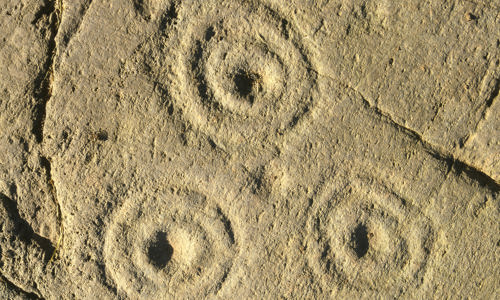History
The rock carvings at Achnabreck are among the largest and most complex motifs in Scotland. Some of the circular hollows, or cup marks, are surrounded by up to 12 rings, more than a metre wide. The cup and ring marks are by far the most common motif, though other decorations can be seen, including:
- multiple rings
- ringed stars
- parallel grooves
- spirals
The spirals are of particular interest, as they are similar to examples found in Ireland and suggest wide-reaching contacts. Some of the carvings appear to overlie others, and there are several different styles and motifs used. This suggests that the carvings at Achnabreck accumulated over a long period.
What do the symbols mean?
We can only speculate what meanings Kilmartin Glen’s prehistoric inhabitants attached to these markings. Apart from the occasional axe, the art is mostly abstract – there are no animal or human figures.
It’s been argued that the rock art should be regarded as a series of messages, with meanings dependent on their landscape. Complex carvings usually occur near lowland sites, while carvings on higher ground tend to be more simple.
A prehistoric landscape
A rich prehistoric landscape survives in Kilmartin Glen, providing a tantalising insight into its prehistoric population. The surviving rock art along the glen is remarkable for the number of elaborately carved outcrops, the style of and extent of the carvings, and their close association with other prehistoric monuments. No other place in Scotland has such a concentration of prehistoric carved stone surfaces, and Neolithic and Bronze Age monuments.
Other carved rock outcrops around Kilmartin Glen include:
Other monuments include:
- Dunadd Hill Fort
- Dunchraigaig Cairn
- Glebe Cairn
- Nether Largie North Cairn
- Nether Largie Mid Cairn
- Nether Largie South Cairn
- Ri-Cruin Cairn
- Temple Wood Stone Circle
The glen is also home to an important collection of medieval sculptured stones.









